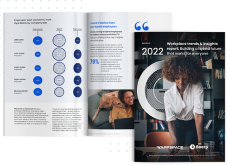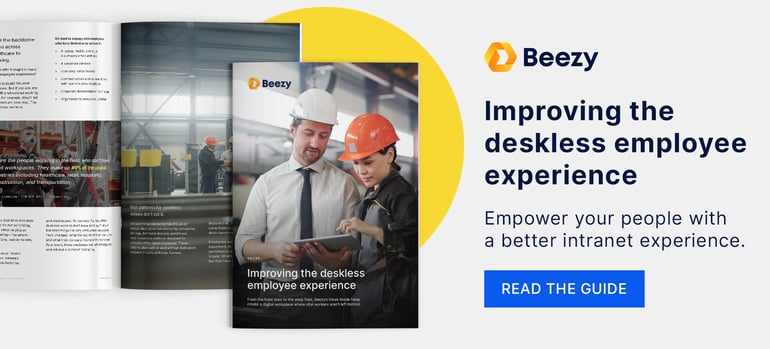
6 employee engagement strategies for frontline workers
Beezy
April 7, 2022As the staff most likely to have face-to-face experiences with your customers, frontline workers are a vital part of building your company’s culture and reputation. But frontline workers are often left out of the conversation about employee engagement, despite making up 80% of the workforce. The result? They can feel disconnected from your company’s vision and values, making it more difficult to bring them into your organization’s shared vision for its future.
The pandemic has been hard for workers of all kinds, but frontline workers have really borne the brunt of the health risks and customer frustrations. This has left many of them disengaged and demoralized: just 41% of frontline workers are engaged at work. Many frontline and deskless workers think of employee engagement strategies as removed from the reality of their day-to-day responsibilities as front-facing staff.
It’s vital for your organization’s success to ensure those engagement strategies resonate with your frontline workforce. Over the years, Gallup research consistently shows that engaged employees produce better business outcomes. That holds during recessions and booming economies, and across different industries and country sizes.
A crisis of low engagement
Right now, about 35% of American employees feel engaged at work and 16% feel actively disengaged, Gallup reports. Engagement that low has real-world consequences – more absenteeism and accidents, higher turnover, and lower customer loyalty and profitability.
Employee engagement isn’t something you can improve by working on it in fits and starts. Your efforts to boost engagement must be continuous and intentional in order to be effective.
6 employee engagement strategies for frontline workers
Put these six employee engagement strategies for frontline workers into action with your internal communications to improve engagement, boost morale, and increase retention and productivity.
1. Make information accessible from anywhere
Your frontline staff doesn’t spend their days sitting at a desk – they need to be able to access vital information about your company from a variety of locations. Make it easy for them to stay up to date on corporate news and updates on the go with a digital workplace solution that can be accessed on mobile, kiosks, and desktop devices.
Your internal communications with frontline workers should allow them to see what’s going on across the organization and easily search for and filter information. When you start from a place of making information widely accessible for all of your staff, your employees will feel informed, safe, and productive.
2. Create engaging content
Entice your frontline workers to access your internal communications regularly by bringing your corporate news to life. Focus on telling compelling stories about your organization and its people, and include engaging visuals like photos and videos. With a solid internal communications strategy, you can create compelling narratives that help your staff understand how they fit into the company’s overall success.
Use publishing and authoring tools to create engaging, attractive content that helps frontline staff understand their role within the company. Free and inexpensive apps like Canva and PS Express make it easy to create and share professional content that fits with your branding and messaging.
3. Prioritize company culture and employee experience
As we come out of the pandemic, employees are burned out and demoralized, across job roles and industry sectors. Over 2021 and into 2022, Bureau of Labor statistics show record numbers of people leaving their jobs, sometimes without a new one set up. Women in particular report high levels of burnout. In hybrid work environments, where some staff are working on the front lines and others are still remote, it can be hard to recognize this disengagement in your staff – and to build the kind of employee experience and company culture that fights against it.
Part of providing that employee experience involves developing good strategy and engaging the right tools, like a digital workplace. But another part comes from deciding it’s a priority and putting that into action – for example, employees who receive daily feedback from their manager are three times as likely to be engaged than those who receive it much less frequently.
4. Foster workplace connections
Digital workplace connections are important for all types of your staff, frontline workers included. By providing your frontline employees with digital solutions that are easy and intuitive to use, you give them opportunities to connect with colleagues across your organization. That means they can develop a sense of community and connection with your company, improving their overall job satisfaction and productivity.
To do this, look for digital tools that mirror popular social networks that your staff likely already use in their personal and professional lives. Make the learning curve an easy one to overcome! Also, ensure that it’s simple for staff to use the tool to look up contact information for colleagues – email, phone, Teams, etc. Then they can communicate how they prefer, and build strong relationships across teams and work sites.
5. Make leadership visible
To get through a difficult time at work, your staff needs to feel like you’re all in it together. That’s hard to foster if your frontline employees never see, hear from, or interact with senior leadership.
Employees want to hear from their workplace leaders, and they want to get important information about their jobs and livelihoods from them first – not through the media or the rumor mill. Ensure that your senior leaders regularly communicate with frontline employees in ways that are both valuable and sincere.
Choose the channels your staff are most likely to engage with, at times that take the pressures of their work days into consideration. Through this intentional, personalized conversation, your senior leaders can set the right tone of support and open communication for the company.
6. Create once and publish anywhere
You can bridge the gap between your organization’s on-site and remote teams with omni-channel publishing tools and digital signage. By sticking to consistent messaging that fits with your corporate tone and values, and using the branding, colors, fonts, and aesthetics that define your company, staff will identify and engage with your messages no matter where they see them.
Consider all the ways in which your frontline employees might see your messages – at work, in advertisements, on their digital workplace, on social media – and design them to work for each one of them. This way, you can tell your company’s story effectively wherever and however your staff is working.
Make sure you include every type of worker when it comes to your employee experience and company culture
Your frontline employees need to know they are an important part of your company culture – not just because that’s how they deserve to feel at work, but because it’s an increasingly key factor for the bottom line.
Employee experience will consume 65% of HR budgets this year. But when your frontline employees know how their role contributes to the organization’s overall success, they’re happier in their jobs and feel empowered to make the necessary decisions to get wins at work.
Want to learn more about engaging and empowering your workforce?
Join our upcoming free webinar with Ragan Communications. Or get this guide to improving the deskless employee experience.



